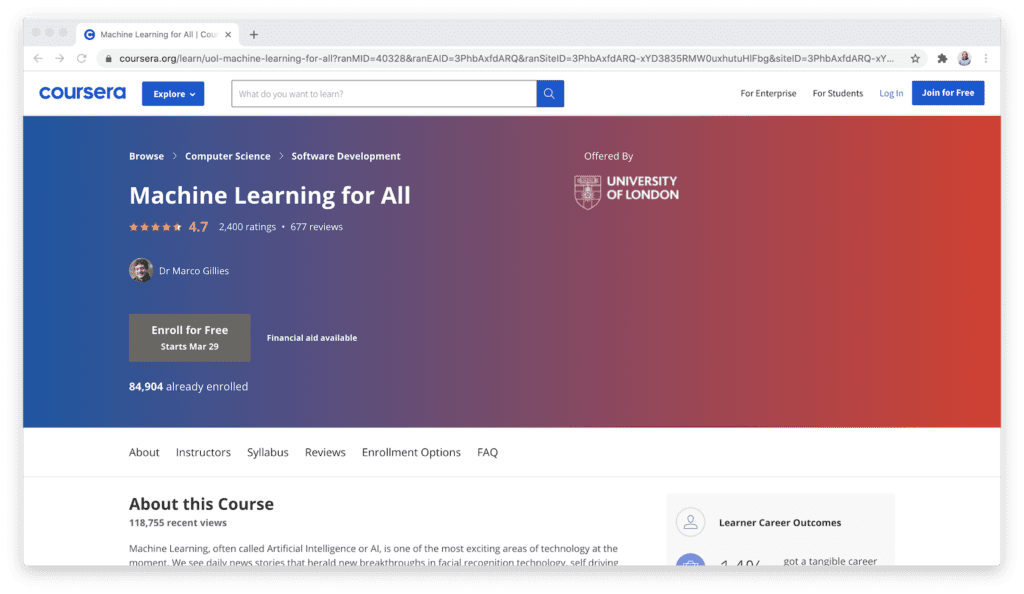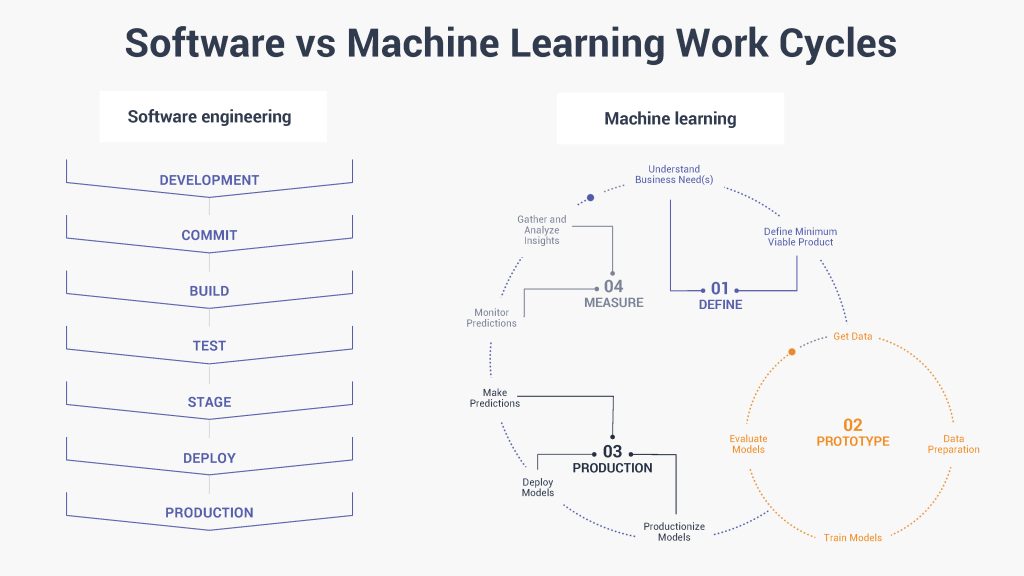All Categories
Featured
Table of Contents
- – An Unbiased View of Become An Ai & Machine Lea...
- – How To Become A Machine Learning Engineer With...
- – The Ultimate Guide To What Is A Machine Learn...
- – Some Known Facts About Embarking On A Self-ta...
- – The Best Strategy To Use For Top 20 Machine ...
- – Getting The Machine Learning Engineer Course...
- – The 7-Second Trick For Top Machine Learning ...
Some people think that that's unfaithful. Well, that's my entire job. If someone else did it, I'm mosting likely to utilize what that individual did. The lesson is putting that apart. I'm requiring myself to analyze the possible solutions. It's even more about consuming the web content and trying to use those concepts and much less regarding discovering a library that does the job or searching for somebody else that coded it.
Dig a little bit deeper in the mathematics at the beginning, simply so I can build that foundation. Santiago: Ultimately, lesson number seven. I do not believe that you have to recognize the nuts and bolts of every algorithm before you utilize it.
I've been using semantic networks for the longest time. I do have a feeling of just how the slope descent functions. I can not discuss it to you right now. I would need to go and examine back to really obtain a far better instinct. That doesn't mean that I can not address points utilizing semantic networks, right? (29:05) Santiago: Trying to require individuals to assume "Well, you're not mosting likely to achieve success unless you can discuss every solitary information of just how this works." It returns to our sorting example I believe that's simply bullshit guidance.
As a designer, I've serviced many, lots of systems and I've made use of lots of, lots of points that I do not recognize the nuts and bolts of exactly how it works, although I comprehend the impact that they have. That's the final lesson on that string. Alexey: The amusing thing is when I consider all these libraries like Scikit-Learn the formulas they make use of inside to apply, for instance, logistic regression or another thing, are not the very same as the formulas we study in artificial intelligence classes.
An Unbiased View of Become An Ai & Machine Learning Engineer
So also if we tried to learn to obtain all these basics of device learning, at the end, the formulas that these libraries utilize are different. Right? (30:22) Santiago: Yeah, definitely. I think we need a great deal a lot more pragmatism in the sector. Make a whole lot even more of an influence. Or concentrating on delivering value and a bit less of purism.

Incidentally, there are two various courses. I normally speak to those that desire to function in the industry that wish to have their effect there. There is a path for scientists and that is entirely different. I do not attempt to talk concerning that due to the fact that I do not know.
But right there outside, in the sector, pragmatism goes a lengthy method without a doubt. (32:13) Alexey: We had a comment that claimed "Feels even more like motivational speech than discussing transitioning." Perhaps we need to switch. (32:40) Santiago: There you go, yeah. (32:48) Alexey: It is a great inspirational speech.
How To Become A Machine Learning Engineer Without ... Things To Know Before You Get This
One of the things I intended to ask you. I am taking a note to talk concerning coming to be better at coding. First, let's cover a couple of things. (32:50) Alexey: Allow's start with core devices and structures that you require to learn to actually shift. Allow's say I am a software application designer.
I recognize Java. I know SQL. I recognize how to use Git. I know Celebration. Possibly I understand Docker. All these things. And I hear concerning machine understanding, it feels like a cool point. What are the core tools and frameworks? Yes, I saw this video clip and I get convinced that I do not need to get deep right into mathematics.
Santiago: Yeah, definitely. I think, number one, you need to begin discovering a little bit of Python. Because you already recognize Java, I don't believe it's going to be a massive shift for you.
Not due to the fact that Python is the exact same as Java, however in a week, you're gon na obtain a lot of the differences there. Santiago: Then you obtain particular core tools that are going to be made use of throughout your whole profession.
The Ultimate Guide To What Is A Machine Learning Engineer (Ml Engineer)?
You get SciKit Learn for the collection of equipment understanding algorithms. Those are tools that you're going to have to be making use of. I do not suggest simply going and finding out regarding them out of the blue.
Take one of those courses that are going to begin introducing you to some troubles and to some core concepts of device knowing. I do not remember the name, yet if you go to Kaggle, they have tutorials there for totally free.
What's great about it is that the only demand for you is to recognize Python. They're mosting likely to offer a problem and inform you how to make use of choice trees to solve that details problem. I assume that process is very effective, because you go from no maker learning history, to understanding what the trouble is and why you can not solve it with what you understand now, which is straight software application design practices.
Some Known Facts About Embarking On A Self-taught Machine Learning Journey.
On the various other hand, ML designers specialize in structure and deploying device learning models. They focus on training designs with information to make forecasts or automate jobs. While there is overlap, AI designers handle more varied AI applications, while ML designers have a narrower concentrate on equipment understanding formulas and their sensible execution.

Maker understanding designers focus on developing and releasing device understanding designs right into manufacturing systems. On the other hand, data researchers have a wider duty that includes data collection, cleaning, expedition, and building versions.
As companies increasingly embrace AI and machine discovering modern technologies, the demand for skilled experts grows. Device understanding engineers function on sophisticated jobs, add to development, and have competitive wages.
ML is fundamentally various from typical software program development as it concentrates on mentor computer systems to pick up from data, instead than shows specific rules that are performed methodically. Unpredictability of end results: You are possibly made use of to composing code with predictable outcomes, whether your function runs when or a thousand times. In ML, nevertheless, the end results are less specific.

Pre-training and fine-tuning: Exactly how these designs are educated on large datasets and after that fine-tuned for certain jobs. Applications of LLMs: Such as text generation, sentiment analysis and details search and access. Documents like "Focus is All You Need" by Vaswani et al., which presented transformers. On the internet tutorials and training courses focusing on NLP and transformers, such as the Hugging Face training course on transformers.
The Best Strategy To Use For Top 20 Machine Learning Bootcamps [+ Selection Guide]
The capability to take care of codebases, merge modifications, and settle conflicts is just as crucial in ML advancement as it is in typical software program tasks. The skills developed in debugging and testing software program applications are highly transferable. While the context may transform from debugging application logic to recognizing problems in data processing or version training the underlying principles of organized investigation, hypothesis screening, and iterative refinement are the very same.
Artificial intelligence, at its core, is greatly dependent on stats and possibility theory. These are vital for comprehending exactly how algorithms gain from data, make forecasts, and review their efficiency. You must think about coming to be comfortable with principles like statistical relevance, distributions, theory screening, and Bayesian thinking in order to design and interpret designs successfully.
For those thinking about LLMs, a complete understanding of deep discovering designs is beneficial. This consists of not only the auto mechanics of semantic networks yet additionally the design of details versions for various usage situations, like CNNs (Convolutional Neural Networks) for image processing and RNNs (Persistent Neural Networks) and transformers for consecutive information and natural language processing.
You should understand these problems and find out strategies for determining, alleviating, and communicating about bias in ML versions. This includes the prospective impact of automated choices and the ethical implications. Lots of designs, especially LLMs, require significant computational resources that are often given by cloud platforms like AWS, Google Cloud, and Azure.
Building these skills will certainly not just facilitate a successful change right into ML but additionally guarantee that programmers can contribute successfully and responsibly to the innovation of this dynamic area. Theory is necessary, however nothing defeats hands-on experience. Beginning dealing with projects that allow you to apply what you have actually found out in a useful context.
Build your projects: Beginning with basic applications, such as a chatbot or a message summarization tool, and progressively enhance intricacy. The field of ML and LLMs is swiftly evolving, with brand-new breakthroughs and technologies arising frequently.
Getting The Machine Learning Engineer Course To Work
Contribute to open-source projects or create blog posts regarding your understanding journey and tasks. As you gain expertise, start looking for chances to integrate ML and LLMs right into your work, or look for brand-new duties concentrated on these innovations.

Vectors, matrices, and their duty in ML algorithms. Terms like model, dataset, attributes, tags, training, inference, and validation. Data collection, preprocessing methods, model training, evaluation procedures, and release considerations.
Decision Trees and Random Woodlands: Intuitive and interpretable designs. Support Vector Machines: Maximum margin classification. Matching trouble kinds with suitable designs. Stabilizing performance and complexity. Fundamental structure of semantic networks: nerve cells, layers, activation features. Split calculation and onward propagation. Feedforward Networks, Convolutional Neural Networks (CNNs), Persistent Neural Networks (RNNs). Image acknowledgment, series forecast, and time-series analysis.
Data flow, change, and attribute design approaches. Scalability concepts and efficiency optimization. API-driven methods and microservices assimilation. Latency management, scalability, and version control. Continual Integration/Continuous Implementation (CI/CD) for ML operations. Model tracking, versioning, and performance monitoring. Finding and attending to adjustments in version efficiency gradually. Dealing with performance bottlenecks and resource administration.
The 7-Second Trick For Top Machine Learning Careers For 2025

Course OverviewMachine learning is the future for the next generation of software experts. This training course functions as an overview to machine understanding for software engineers. You'll be introduced to three of the most pertinent parts of the AI/ML self-control; overseen knowing, semantic networks, and deep discovering. You'll realize the differences between traditional shows and artificial intelligence by hands-on advancement in monitored discovering before constructing out intricate dispersed applications with neural networks.
This program works as an overview to maker lear ... Show More.
Table of Contents
- – An Unbiased View of Become An Ai & Machine Lea...
- – How To Become A Machine Learning Engineer With...
- – The Ultimate Guide To What Is A Machine Learn...
- – Some Known Facts About Embarking On A Self-ta...
- – The Best Strategy To Use For Top 20 Machine ...
- – Getting The Machine Learning Engineer Course...
- – The 7-Second Trick For Top Machine Learning ...
Latest Posts
The Best Free Coding Interview Prep Courses In 2025
Why Faang Companies Focus On Problem-solving Skills In Interviews
The Ultimate Software Engineering Interview Checklist – Preparation Guide
More
Latest Posts
The Best Free Coding Interview Prep Courses In 2025
Why Faang Companies Focus On Problem-solving Skills In Interviews
The Ultimate Software Engineering Interview Checklist – Preparation Guide